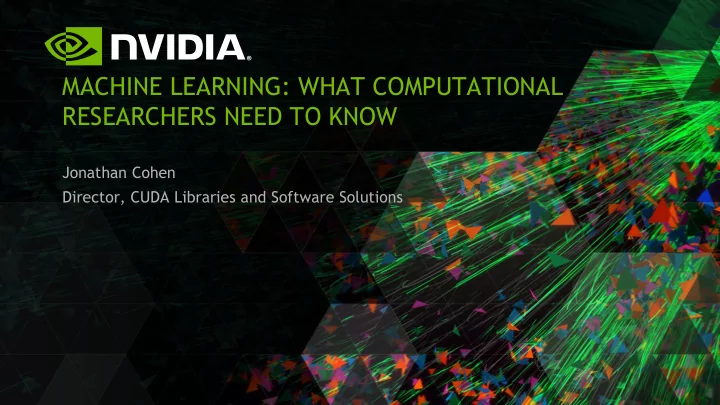

MACHINE LEARNING: WHAT COMPUTATIONAL RESEARCHERS NEED TO KNOW Jonathan Cohen Director, CUDA Libraries and Software Solutions
2
3
COMPUTERS ARE LEARNING TO SEE! GPU Entries 120 Image Recognition Challenge 100 110 80 1.2M training images • 1000 object categories 60 60 40 Hosted by 20 4 0 2010 2011 2012 2013 2014 Classification Error Rates person car bird 30% 28% 26% helmet frog 25% motorcycle 20% 16% 15% 12% 10% person 7% person 5% hammer dog 0% flower pot chair 2010 2011 2012 2013 2014 power drill 4
DEEP NEURAL NETS: ANALYSIS VIA ABSTRACTION “Sara” Image 5
Machine Learning Software Forward Propagation Repeat “turtle” Tree Training Backward Propagation Cat Compute weight update to nudge f rom “turtle” towards “dog” Dog Trained Model Classification “cat” 6
Deep Learning for Science 7
CORAL REEF MAPPING Coral reefs tremendously important Support more species per area than any other marine environment Storehouse of immense biodiversity Buffer adjacent shorelines from wave action Ecologists need accurate large-scale coverage, broken down by genus Surveys generate huge data sets… 8 Material courtesy Oscar Beijbom and CoralNet advisory team / UCSD
LARGE SCALE CORAL ANNOTATION CoralNet @ UCSD … but labeling is tedious and slow Anecdotally only 1-2% of image data obtained from coral reef surveys is labeled Automated methods: best methods today work on 60% of data with 5% loss of accuracy Deep learning: estimated to work on 90% of data (pilot study underway) Circles are coral genera Acropora,, Pavona,, Montipora,, Pocillopora,,and Porites More at: http://coralnet.ucsd.edu/ Triangles are non-coral substrates, Crustose Coralline Algae,,Turf algae,,Macroalgae, and Sand. 9 Material courtesy Oscar Beijbom and CoralNet advisory team / UCSD
CONNECTOME PROJECT Mapping the Brain’s Wiring Diagram “ Imaging neural circuits at nanometer length scales leads inevitably to vast data sets. In fact, the entire Connectome Project is feasible only now because of the exponential increase in computing power and data storage over time. Nevertheless, managing, visualizing, and analyzing these data remain major challenges. ” – Harvard Center for Brain Science website 10
NEURAL NET SEGMENTING NEURON DATA Microscopy Image Neural Net Classifier Segmentation Microscope generates 0.85 TB / day 250 NVIDIA Tesla K40 GPUs running classifier Next-gen will generate 1GB/sec , running 50% of the time That will be 42TB / day 11 Images courtesy Thouis Jones
http://www.youtube.com/watch?v=-wq2WTRmeW4 Credits: Daniel Berger and Sebastian Seung (MIT); Narayanan Kasthuri, Richard Schalek, Kenneth Hayworth, Juan-Carlos Tapia and Jeff Lichtman (Harvard). 12
CANCER CELL MITOSIS DETECTION Mitosis: Chromosomes in cell nucleus replicated prior to cell splitting “B&R” grading system includes mitotic activity per tissue area – strong indicator of invasive breast cancer Hand count mitosis events over 2mm 2 region in stained slide 13
DEEP NEURAL NETS FOR MITOSIS DETECTION IDSIA – Winner 2012 & 2013 Contests MICCAI 2013 0.7 Use DNNs as pixel classifier input: window of raw pixels 0.6 output: probability center pixel is close to mitosis centroid 0.5 0.4 F1 score 2012 contest: 66k pos examples, 6M neg examples 5 months to train on CPU 0.3 3 days to train on GPU! 0.2 0.1 See: Dan Ciresan, Mitosis Detection in Breast Cancer Histology Images with Deep Neural Networks – 0 NVIDIA GPU Theater, Tuesday 2:30-2:50 IDSIA other entries 14 Material courtesy Dan Ciresan, IDSIA
How to Get Started 15
ANYONE CAN USE DEEP LEARNING Machine Learning Will Impact all of Science Several open source frameworks available with active communities Caffe (UCB), Torch (NYU), Theano (Montreal) – take your pick Caffe: http://caffe.berkeleyvision.org/tutorial/ Torch: http://code.cogbits.com/wiki/doku.php Theano: http://deeplearning.net/software/theano/tutorial/ All have excellent support for NVIDIA GPUs Astronomy, sociology, political science, marine ecology, medical imaging, genomics, plant biology, archaeology, … 16
GPU-ACCELERATED DEEP LEARNING High performance routines for Convolutional Neural Networks Optimized for current and future NVIDIA GPUs Caffe Integrated in major open-source frameworks (cuDNN) Caffe 14x (GPU) Caffe, Torch7, Theano 11x Flexible and easy-to-use API Caffe (CPU*) Also available for ARM / Jetson TK1 1x Baseline Caffe compared to Caffe https://developer.nvidia.com/cuDNN accelerated by cuDNN on K40 17 *CPU is 24 core E5-2697v2 @ 2.4GHz Intel MKL 11.1.3
Recommend
More recommend